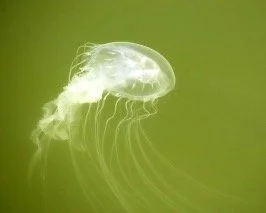Jelly Watch
by Terese Schlachter
We, the frequently submerged, have all felt the slither. The one that, just as you’re settling into an open water rhythm, grazes an arm, a leg, a lip maybe. Your head snaps to attention, your seasoned, graceful stroke jerks to a halt, and you let out an involuntary yelp. Likely, it’s the all-too-common Chrysaora chesapeakei that’s drifted into your swim space. We refer to them, colloquially, as “jellies.”
The jellyfish season has once again gripped the coastal Chesapeake’s swimming community in its slippery tentacles and won’t be letting go until late fall. While this year’s crop seems, anecdotally, sparser and perhaps less developed than in other years, it’s emerged fully enough to cast a cloud of apprehension along the swim capped and goggled shore population.
And yet. The nasty nettles do have their fans, their admirers, their Swiftie-like followers. Okay, follower. There’s this one guy…
“Their simple design is elegant, almost,” says Monty Graham, the new director at the Smithsonian Environmental Research Center in Edgewater. Graham has been studying coastal ecological oceanography for some 30 years, specifically focusing on jellyfish since he graduated from the University of North Carolina. He was drawn in through an internship studying cannonball jellyfish.
William “Monty” Graham was honored in 2022 by colleagues who named a new species of jellyfish after him: the Aurelia montyi
“The cannonball jellyfish were all swimming in the same direction and the (scientists) wanted to know why,” recalls Graham, “So I discovered this quirky, ancient animal that could have behaviors but (had) no brain.” And so, his love affair with the gelatinous, watery drifters was born.
Jellyfish have been around for more than 500 million years, says Graham. They were among the first metazoans, that is, organisms having more than one cell. They don’t have organs; they’re made mostly of water and two layers of tissue. “Their design is perfect. They are born, they grow, they feed and reproduce. That’s why they’ve been successful.”
Jellyfish fossil (credit: Smithsonian Ocean)
Unfortunately for the local open water swimmer, jellies have found ample “success” in the Chesapeake. But contrary to what some may think, they don’t swim in from other locations. They bloom here.
Jellyfish reproduce by snugging up close together and releasing sperm and eggs into the water, which combine to form larvae, which float off and attach themselves to something solid, like a dock or an abandoned shell, where they grow into polyps. When water temperatures, food sources and salinity combine to create the perfect environment, the polyps elongate into what Graham says looks like a tiny stack of dinner plates. Eventually they break off and become ephyra or baby (juvenile) jellyfish. Due to their uncomplicated anatomy, they grow quickly. And the bloom is on.
Their sting is not usually dangerous, just off-putting. (An exception is the Portuguese Man of War, which has tentacles 30 – 50 feet long, and can deliver a nasty sting) Jellyfish are more of a nuisance than they are menacing but have been known to occasionally muck up the works.
Graham was once called upon to consult with the U.S. Navy when one of its nuclear carriers found itself paralyzed in the Gulf of Oman during the first Gulf War. Nuclear carriers are powered by reactors that generate steam. The ship uses strained and treated sea water to cool the reactors. But a massive jellyfish bloom wrought havoc on the system by clogging the strainers.
On another occasion in the Philippines, an enormous bloom of jellies clogged a coal-fired plant on the island of Luzon, leaving 40 million people without power and sparking rumors of a military coup. Seventy dump trucks full of jellyfish were cleaned from the intake line. Luckily, no shots were fired.
Jellies are not intentionally troublesome. They drift with currents rather than swim. If you’re stung, it’s likely the result of a “bumping into,” rather than an attack. But they sting instantly. “Jellyfish have to paralyze their prey quickly, or it will get away,” says Graham. They’re stringy, not strong. They manage only to dissolve their food into their tentacles and transfer it to the “stomach area.” Jellyfish don’t really have organs, per say.
Seems there’s a jellyfish for nearly every season on the Chesapeake. Through the winter and early spring, you might see Lion’s Mane jellyfish, which have a slightly brown or orange hue. Moon jellyfish, which may be larger than the Chrysaora Chesapeakei, is somewhat more sophisticated in that it can sense light and react to it. They can grow as large as a regular sized dinner plate, and have many, short tentacles.
Those jellies which exhibit behaviors, that is, they react to stimulus, can have, through scientific research and study, “huge implications” for solving global problems, according to Graham. They’re an important part of the ecosystem, too. So, the next time you’re standing on the shore wishing the jellyfish away, it may be helpful to consider the benefits.
But don’t get too chummy, Graham warns. “Anything with tentacles will sting you.”
The Bay Jellyfish or Chrysaora chesapeakei (credit Wayne Longbottom, iNaturalist)
Lion’s Mane jellyfish (credit: Rita Jansen, iNaturalist)
The common Moon jellyfish (credit: Jessica Kir, iNaturalist)





